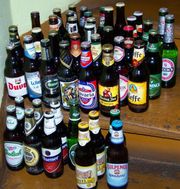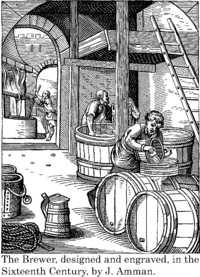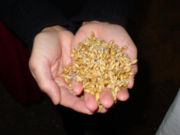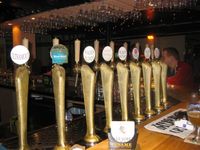Beer
2007 Schools Wikipedia Selection. Related subjects: Drink
Beer is one of the world's oldest alcoholic beverages, possibly brewed for the first time over 10,000 years ago, according to renowned beer writer Michael Jackson. It is a fermented beverage most often made from malted barley, hops, yeast and water, and is carbonated in almost all cases. By altering the production method (changes in time and temperature, for example) or the ingredients, a staggeringly wide variety of different types of beer can be produced. Much like fine wines, many beers can also be aged and evolve into beverages that defy the common definitions of beer.
History
Beer is one of the oldest human-produced beverages, possibly dating back to at least the 7th millennium BC (perhaps prior even to bread), and recorded in the written history of Ancient Egypt and Mesopotamia. Earliest known chemical evidence of beer dates to circa 3500-3100 BC. As almost any substance containing carbohydrates, namely sugar or starch, can naturally undergo fermentation, it is likely that beer-like beverages were independently invented among various cultures throughout the world.
In Egypt, Mesopotamia, and the Levant, large-scale production of beer was common. In Europe, beer was being produced by or for monasteries as early as the 7th century. By the 14th and 15th centuries, beer had achieved great popularity, at least in part because health epidemics made drinking beer safer than drinking water. However it was not until the 17th century, according to Michael Jackson, that beer took on the styles and flavours that we might recognise in the beers of today.
Today, the brewing industry is a huge global business, consisting of several multinational companies, and many thousands of smaller producers ranging from brewpubs to regional breweries.
Brewing
Though the process of brewing beer is complex and varies considerably, the basic stages that are consistent are outlined below. There may be additional filtration steps between stages.
- Mashing: The first phase of brewing, in which the malted grains are crushed and soaked in warm water in order to create a malt extract. The mash is held at constant temperature long enough for enzymes to convert starches into fermentable sugars, usually about 45 to 90 minutes, depending on mash temperature (high temperatures = faster). The temperature is typically held at either a single temperature (single step) or a series of temperatures depending on the enzymes one wants to focus on. Typically with modern fully-modified malts, a single-stage infusion is all that is required. For most mashes, a temperature between 65-67°C (150-154°F) is typical, with higher temperatures yielding fuller bodied beers, and lower temperatures yielding more fermentable and lighter bodied beers. Multi-temperature mashes are used for acid-buffering reactions and protein rests for head-retention for some types of malts.
- Sparging: Water is filtered through the mash to dissolve the sugars. The darker, sugar-heavy liquid is called the wort. Typically the rinse water (sparge) is held between 76-82°C (170-180°F) to (1) keep sugars and gums from setting up and (2) above 82°C (180°F), tannin extraction could be a problem.
- Boiling: The wort is boiled along with any remaining ingredients (excluding yeast), to remove excess water and kill any microorganisms. The main function of boiling is to set proteins and such similar to cooking bread. The hops (whole, pelleted, or extract) are added at some stage during the boil. Bittering hops are added during the entire boil (1 hour +), flavoring are added between about 5 - 20 minutes, and aroma hops are added at 5 minutes or less.
- Fermentation: The yeast is added (or "pitched") and the beer is left to ferment. After primary fermentation, the beer may be allowed a second fermentation, which allows further settling of yeast and other particulate matter ("trub") which may have been introduced earlier in the process. Some brewers may skip the secondary fermentation and simply filter off the yeast.
- Packaging: At this point, the beer contains alcohol, but not much carbon dioxide. The brewer has a few options to increase carbon dioxide levels. The most common approach by large-scale brewers is force carbonation, via the direct addition of CO2 gas to the keg or bottle. Smaller-scale or more classically-minded brewers will add extra ("priming") sugar (usually about 5 oz corn sugar per 5 gal) or a small amount of newly fermenting wort ("kräusen") to the final vessel, resulting in a short refermentation known as "cask-" or "bottle conditioning". This can be done by "bulk priming" or "bottle priming" methods. Bulk priming is the process of addiing the additional sugar to the entirety of the beer. Bottle priming is adding it to each bottle individually.
After brewing, the beer is usually a finished product. At this point the beer is kegged, casked, bottled, or canned.
Unfiltered beers may be stored for further fermentation in conditioning tanks, casks or bottles to allow smoothing of harsh alcohol notes, integration of heavy hop flavours, and/or the introduction of oxidised notes such as wine or sherry flavours. Some beer enthusiasts consider a long conditioning period attractive for various strong beers such as Barley wines. There are some beer cafes in Europe, such as Kulminator in Antwerp, which stock beers aged ten years or more. Aged beers such as Bass Kings Ale from 1902, Courage Imperial Russian Stout and Thomas Hardys Ale are particularly valued.
Ingredients
The basic ingredients of beer are water, a fermentable starch source, such as malted barley, and yeast. It is common for a flavouring to be added, the most popular being hops. A mixture of starch sources may be used, with the secondary starch source, such as corn, rice and sugar, often being termed an adjunct, especially when used as a lower cost substitute for malted barley.
Water
Beer is composed mainly of water, which when heated is known as brewing liquor. The characteristics of the water have an influence on the character of the beer. Although the effect of, and interactions between, various dissolved minerals in brewing water is complex, as a general rule, hard water is more suited to dark beer such as stout, while very soft water is more suited for brewing pale ale and pale lager.
Hops
Hops have commonly been used as a bittering agent in beer for over a thousand years, the earliest evidence of cultivation for this purpose dates back to the seventeenth century (according to Judith M. Bennett). Hops contain several characteristics very favourable to beer: (a) hops contribute a bitterness that balances the sweetness of the malt, (b) hops also contribute aromas which range from flowery to citrus to herbal, (c) hops have an antibiotic effect that favours the activity of brewer's yeast over less desirable microorganisms and (d) the use of hops aids in " head retention", the length of time that a foamy head created by the beer's carbonation agent will last. The bitterness of commercially-brewed beers is measured on the International Bitterness Units scale. While hop plants are grown by farmers all around the world in many different varieties, there is no major commercial use for hops other than in beer.
Yeast
A microorganism that is responsible for fermentation. A specific strain of yeast is chosen depending on the type of beer being produced, the two main strains being ale yeast ( Saccharomyces cerevisiae) and lager yeast ( Saccharomyces uvarum), with some other variations available, such as Brettanomyces and Torulaspora delbrueckii. Yeast will metabolise the sugars extracted from the grains, and produce alcohol and carbon dioxide as a result. Before yeast's functions were understood, fermentations were conducted naturally using wild or airborne yeasts; although a few styles such as lambics still rely on this ancient method, most modern fermentations are conducted using pure yeast cultures.
Clarifying agent
Some brewers add one or more clarifying agents to beer that are not required to be published as ingredients. Common examples of these include Isinglass finings, obtained from swimbladders of fish; kappa carrageenan, derived from seaweed; Irish moss, a type of red alga; polyclar (artificial), and gelatin.
Styles
A great many different types, or styles, of beer are brewed across the globe. The traditional European brewing nations - the United Kingdom, Ireland, Germany, Belgium, the Czech Republic, Denmark, The Netherlands and Austria - all have their own beer styles. These form the basis of the vast majority of beer brewed around the world. In some countries - notably the USA, Canada and Australia - brewers have adapted European styles to such an extent that they have effectively created their own indigenous types.
The greatest diversity of flavours and types of beer can be found in Belgium, as demonstrated by its trappist, lambic and other beer styles. Germany too has a history of regional beer types, however, over time, some of these beers have disappeared.
In tasting a beer for the first time, you might begin by asking: do I like this beer and why? Rather than concerning yourself with the beer's style, you might consider some of the physical attributes of the beer: aroma, appearance, mouthfeel (does it feel thin, creamy, syrupy in your mouth?), taste (sour, sweet, bitter, etc.) and the lack or presence of discernible alcohol. There are no "right" or "wrong" answers -- it's all a matter of taste.
Categorising by yeast
A common method of categorising beer is by the behaviour of the yeast used in the fermentation process. In this method of categorising, those beers which use a fast acting yeast which leaves behind residual sugars are termed ales, while those beers which use a slower and longer acting yeast which removes most of the sugars leaving a clean and dry beer are termed lagers.
Ale
A modern ale is commonly defined by the strain of yeast used and the fermenting temperature.
Ales are normally brewed with top-fermenting yeasts, though a number of British brewers, including Fullers and Weltons, use ale yeast strains that have less pronounced top-fermentation characteristics. The important distinction for ales is that they are fermented at higher temperatures and thus ferment more quickly than lagers.
Ale is typically fermented at temperatures between 15 and 24 °C (60 and 75 °F). At these temperatures, yeast produces significant amounts of esters and other secondary flavour and aroma products, and the result is often a beer with slightly "fruity" compounds resembling but not limited to apple, pear, pineapple, banana, plum, or prune. Typical ales have a sweeter, fuller body than lagers.
Differences between some ales and lagers can be difficult to categorise. Steam beer, Kölsch, Alt and some modern British Golden Summer Beers use elements of both lager and ale production. Baltic Porter and Bière de Garde may be produced by either lager or ale methods or a combination of both. However, lager production is perceived to produce cleaner tasting, dryer and lighter beer than ale.
Lager
Lager is the English name for bottom-fermenting beers of Central European origin. They are the most commonly-consumed beer in the world. The name comes from the German lagern ("to store"). Lager yeast is a bottom-fermenting yeast, and typically undergoes primary fermentation at 7-12 °C (45-55 °F) (the "fermentation phase"), and then is given a long secondary fermentation at 0-4 °C (32-40 °F) (the "lagering phase"). During the secondary stage, the lager clears and mellows. The cooler conditions also inhibit the natural production of esters and other byproducts, resulting in a "crisper" tasting beer.
Modern methods of producing lager were pioneered by Gabriel Sedlmayr the Younger, who perfected dark brown lagers at the Spaten Brewery in Bavaria, and Anton Dreher, who began brewing a lager, probably of amber-red colour, in Vienna in 1840–1841. With modern improved yeast strains, most lager breweries use only short periods of cold storage, typically 1–3 weeks.
The lagering phase is not restricted to lager beers. In Germany, all beers are stored at low temperatures before consumption; in the British tradition, the practice of Cold Conditioning is similar in nature.
Lambic beers: spontaneous fermentation
Lambic beers use wild yeasts, rather than cultivated ones. Many of these are not related to brewer's yeast (Saccharomyces), and may have significant differences in aroma and sourness.
Pale and dark beer
The most common colour is a pale amber produced from using pale malts. Pale lager is a term used for beers made from malt dried with coke. Coke had been first used for roasting malt in 1642, but it wasn't until around 1703 that the term pale ale was first used. In terms of volume, most of today's beer is based on the pale lager brewed in 1842 in the town of Plzeň, in the Czech Republic. The modern Pilsner lager is light in colour and high in carbonation, with a strong hop flavour and an alcohol by volume content of around 5%. The Pilsner Urquell and Heineken brands of beer are typical examples of pale lager, as are the American brands Budweiser, Coors, and Miller.
Dark beers are usually brewed from a pale malt or pils malt base with a small proportion of darker malt added to achieve the desired shade. Other colourants - such as caramel - are also widely used to darken beers. Very dark beers, such as stout, use dark or patent malts. These have been roasted longer.
Serving
Draught and keg
Draught beer from a pressurized keg is the most common dispense method in bars around the world. A metal keg is pressurized with carbon dioxide (CO2) gas which drives the beer to the dispensing tap or faucet. Some beers, notably stouts, such as Guinness and "Smooth" bitters, such as Boddingtons, may be served with a nitrogen/carbon dioxide mixture. Nitrogen produces fine bubbles, resulting in a dense head and a creamy mouthfeel.
In the 1980s Guinness introduced the beer widget, a nitrogen pressurized ball inside a can which creates a foamy head. The words "draft" and "draught" are often used as marketing terms to describe canned or bottled beers containing a beer widget.
Cask ales
Cask ales are unfiltered and unpasteurised. Typically, when a cask arrives in a pub, it is placed horizontally on a stillage and allowed to cool to cellar temperature (typically around 13°C / 55.4°F), before being tapped and vented — a tap is driven through a (usually rubber) bung at the bottom of one end, and a hard spile or other implement is used to open a hole in the side of the cask, which is now uppermost. The act of stillaging and then venting a beer in this manner typically disturbs all the sediment, so it must be left for a suitable period to "drop" (clear) again, as well as to fully condition — this period can anywhere from several hours to several days. At this point the beer is ready to sell, either being pulled through a beer line with a hand pump, or simply being "gravity-fed" directly into the glass.
Bottles
Most beers are filtered before bottling. See Filtered beer. But some are bottle conditioned.
Bottle conditioned beers are unfiltered and unpasteurised. It is usually recommended that the beer is poured slowly, leaving any yeast sediment at the bottom of the bottle. However, some drinkers prefer to pour in the yeast, and this practice is customary with wheat beers. Typically when serving a hefeweizen 90% of the contents is poured and the remainder swirled to suspend the sediment before pouring it into the glass.
Cans
A lot of beer is sold in beer cans, though there is considerable variation in the proportion between different countries. In Sweden 60% of beer is sold in cans, in Denmark none at all. People either drink from the can or pour the beer into a glass. Cans are commonly associated with cheap, mass-produced American beer such as Budwieser and Miller. Imported and micro-brewed beers are usually purchased in beer bottles.
Serving temperature
The temperature of a beer has an influence on a drinker's experience. Colder temperatures allow fully attenuated beers such as pale lagers to be enjoyed for their crispness; while warmer temperatures allow the more rounded flavours of an ale or a stout to be perceived. Beer writer Michael Jackson proposes a five-level scale for serving temperatures: well chilled (7°C/45°F) for "light" beers (American and Australian lagers), chilled (8°C/47°F) for Berliner Weisse, lightly chilled (9C/48F) for European lagers, all dark lagers, altbier and German wheat beers, cellar temperature (13°C/55°F) for regular British ale, stout and most Belgian specialities and room temperature (15.5°C/60°F) for strong dark ales (especially trappist) and barley wine.
Culture
Social context
Various social traditions and activities are associated with beer drinking, such as playing cards, darts or other pub games; attending beer festivals, or visiting a series of different pubs in one evening; rating beer; joining an organisation such as CAMRA; or brewing beer at home. Various drinking games, such as beer pong, and Quarters are also very popular.
International consumption
Beer is considered to be a social lubricant in many societies. Beer is consumed in countries all over the world. There are breweries in Middle Eastern countries such as Iraq and Syria as well as African countries (see African beer) and remote countries such as Mongolia. Sales of beer are four times as much as wine, the second most popular alcoholic beverage.
Vessels
Beer is drunk from a variety of vessels, such as a glass, a beer stein, a mug, a pewter tankard or even a beer bottle or can. Many drinkers consider that the type of vessel influences their enjoyment of the beer. In Europe, many breweries produce glassware intended only for their own beers. Most drinkers expect their beer to be served in a glass, preferably the glass chosen by the brewery.
The pouring process has an influence on a beer's presentation.
The rate of flow from the tap or other serving vessel, tilt of the glass, and position of the pour (in the centre or down the side) into the glass all influence the end result, such as the size and longevity of the head, lacing (the pattern left by the head as it moves down the glass as the beer is drunk), and turbulence of the beer and its release of carbonation.
Unfiltered bottled beers may be served with the addition of the remaining yeast at the bottom of the bottle to add both flavour and colour.
Rating
Rating beer is a recent craze that combines the enjoyment of beer drinking with the hobby of collecting. People drink beer and then record their scores and comments on various internet websites. This is a worldwide activity and people in the USA will swap bottles of beer with people living in New Zealand and Russia. People's scores may be tallied together to create lists of the most popular beers in each country as well as the most highly rated beers in the world.
Health effects
Beer contains alcohol which has a number of health risks and benefits. However, beer includes a wide variety of other agents that are currently undergoing scientific evaluation.
Brewer's yeast is known to be a rich source of nutrients; therefore, as expected, beer can contain significant amounts of nutrients, including magnesium, selenium, potassium, phosphorus, biotin, and B vitamins. In fact, beer is sometimes referred to as "liquid bread" . Typically, the darker the brew, the more nutrient dense, with some sources maintaining that filtered beer loses much of its nutrition ,.
A 2005 Japanese study found that non-alcoholic beer may possess strong anti-cancer properties. Another study found nonalcoholic beer to mirror the cardiovascular benefits associated with moderate consumption of alcoholic beverages.
It is considered that over-eating and lack of muscle tone is the main cause of a beer belly, rather than beer consumption. A recent study, however, found a link between binge drinking and a beer belly. But with most overconsumption it is more a problem of improper exercise and overconsumption of carbohydrates than the product itself .
There is strong evidence that prolonged consumption of alcohol, especially in high volumes, can not only lead to liver damage but leaves the organ vulnerable to cancer cells.
Strength
The alcohol content of beers varies by local custom. British ales average around 4% abv, while Belgian beers tend to average 8% abv. The strength of the typical global pale lager is 5% abv.
Typical brewing yeast cannot reproduce (and therefore cannot produce alcohol) above 12% abv. However, in the 1980s the Swiss brewery Hürlimann developed a yeast strain which could get as high as 14% for their Samichlaus beer.
Some brewers use champagne yeasts to artificially increase the alcohol content of their beers. Samuel Adams reached 20% abv with Millennium and then surpassed that amount to 25.6% abv with Utopias. The strongest beer sold in Britain was Dogfish Head's World Wide Stout, a 21% abv stout which was available from UK Safeways in 2003. In Japan in 2005, the Hakusekikan Beer Restaurant sold an eisbock, strengthened through freezing, believed to be 28% abv. The beer that is considered to be the strongest yet made is Hair of the Dog's Dave - a 29% abv barley wine made in 1994.
Related beverages
- See Category:Fermented beverages
There are a number of related beverages such as kvass, sahti and pulque.
- Africa: Hundreds of local drinks made from millet, sorghum, and other available starch crops.
- Andes, South America: Chicha, an Andean beverage made from germinated maize.
- Bhutan, Nepal, Tibet and Sikkim: Chhaang, a popular semi-fermented rice/millet drink in the eastern Himalaya.
- China: Jiǔ refers to all alcoholic drinks, most of which are distilled liquors (báijiǔ), but there are traditional grain-based relatives of beer such as sulima, made by the Mosuo people, and lijiang yinjiu, made by the Nakhi people, both in the Lijiang region of Yunnan.
- Finland: Sahti, a traditional Finnish beer.
- Indonesia: Brem, a Balinese fermented rice wine.
- Japan: Sake, a rice-based fermented drink.
- Korea: Soju
- Kyrgyzstan, Kazakhstan, Mongolia: Kumis (in Kyrgyz called kymyz), is the fermented mare's milk drink popular in many parts of Central Asia and Mongolia. It is very easy to obtain as it is sold in any market and at small stands on the side of the highway in rural areas as a source of income for the local nomads.
- Kyrgyzstan: Bozo is a low alcohol, somewhat porridgey drink made from millet. The Kyrgyz are also fans of kymyz (see kumis).
- Mexico: Pulque, an indigenous beer made from the fermented sap of the agave plant.
- Russia/Ukraine: Kvass, a fermented nonalcoholic or mildly alcoholic beverage.
- Bouza: An ancient Egyptian beer made from bread which is still made in Sudan.
- Some Celtic peoples of the European Iron Age drank, according to some classical sources, a type of beer known as korma.









